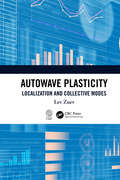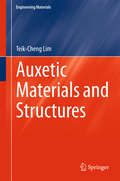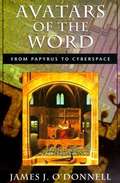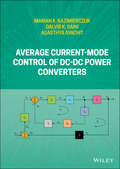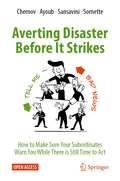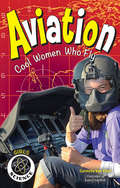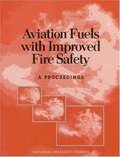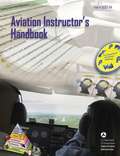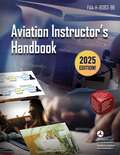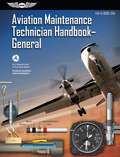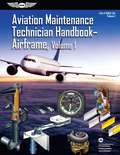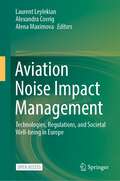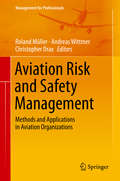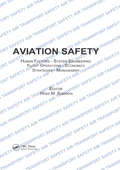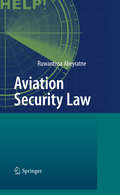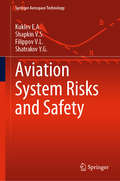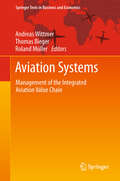- Table View
- List View
Autotrophic Nitrogen Removal from Low Concentrated Effluents: Study of System Configurations and Operational Features for Post-treatment of Anaerobic Effluents (IHE Delft PhD Thesis Series)
by Javier Adrián Sánchez GuillénOn a global scale, sewage represents the main point-source of water pollution and is also the predominant source of nitrogen contamination in urban regions. The present research is focused on the study of the main challenges that need to be addressed in order to achieve a successful inorganic nitrogen post-treatment of anaerobic effluents in the mainstream. The post-treatment is based on autotrophic nitrogen removal. The challenges are classified in terms of operational features and system configuration, namely: (i) the short-term effects of organic carbon source, the COD/N ratio and the temperature on the autotrophic nitrogen removal; the results from this study confirms that the Anammox activity is strongly influenced by temperature, in spite of the COD source and COD/N ratios applied. (ii) The long-term performance of the Anammox process under low nitrogen sludge loading rate (NSLR) and moderate to low temperatures; it demonstrates that NSLR affects nitrogen removal efficiency, granular size and biomass concentration of the bioreactor. (iii) The Anammox cultivation in a closed sponge-bed trickling filter (CSTF) and (iv) the autotrophic nitrogen removal over nitrite in a sponge-bed trickling filter (STF). Both types of Anammox sponge-bed trickling filters offer a plane technology with good nitrogen removal efficiency.
Autowave Plasticity: Localization and Collective Modes
by Lev ZuevAutowave Plasticity: Localization and Collective Modes discusses the nature of plastic flow in solids associated with the development of a localized plastic flow. Written by an authority in the field, the author demonstrates how patterns of localized plastic flow are associated with autowave modes that are generated in a deformable sample and delivers a complete work on the subject. Key Features An original work on the nature of plastic flows in solids, particularly metals and crystals Focuses on plastic flow as an autowave process Contains elements of theories, experimental considerations, and numerical modeling This reference will help readers with creating experimental methods to observe or localize plastic flow and with the modeling of plastic flows. It is a valuable reference for graduate students and research specialists working in material science.
Auxetic Materials and Structures (Engineering Materials)
by Teik-Cheng LimThis book lays down the foundation on the mechanics and design of auxetic solids and structures, solids that possess negative Poisson's ratio. It will benefit two groups of readers: (a) industry practitioners, such as product and structural designers, who need to control mechanical stress distributions using auxetic materials, and (b) academic researchers and students who intend to produce unique mechanical and other physical properties of structures using auxetic materials.
Auxins, Cytokinins and Gibberellins Signaling in Plants (Signaling and Communication in Plants)
by Tariq AftabPlant hormones have pivotal roles in the regulation of plant growth, development, and reproduction. Their signaling pathways are interconnected in a complex network, which provides plants with an enormous regulatory potential to rapidly adapt to their environment and to utilize their limited resources for growth and survival in a cost-efficient manner. Auxin is a hormone molecule whose activity levels are most important for its regulatory roles during plant cell, organ, and tissue development. Therefore, the precise regulation of auxin levels is an essential mechanism to fine-tune the activity of this powerful hormone during plant growth and development. Likewise, cytokinins exhibit a wide range of physiological functions, including regulation of shoot and root apical meristems, stimulation of branching, vascular development, chloroplast differentiation, stabilization of the structure and function of the photosynthetic machinery, delay of senescence, stomata opening, and elevation of the sink strength and nutritional signaling. Moreover, gibberellins also regulate many aspects of plant growth and development including seed germination, stem elongation, leaf expansion, and flower and fruit development. The broad implication of gibberellins in plant development is strictly associated with tight regulation of their metabolism by multiple environmental and endogenous factors, ranging from light and temperature to other hormones including feedback control. Understanding the significant roles of these phytohormones in plant biology, the current subject has attracted the attention of scientists from across the globe. This comprehensive volume “Auxins, Cytokinins and Gibberellins Signaling in Plants” highlights the various prospects involved in the current scenario. The book comprises the chapters from diverse areas dealing with biotechnology, molecular biology, proteomics, genomics, metabolomics, etc.
Avalon
by Mindee ArnettFor fans of Josh Whedon's cult classic television show Firefly comes a fascinating and fast-paced sci-fi thriller from author Mindee Arnett, about a group of teenage mercenaries who stumble upon a conspiracy that threatens the entire galaxy.Jeth Seagrave and his crew have made their name stealing metatech: the devices that allow people to travel great distances faster than the speed of light. In a world where the agencies that patrol the outer edges of space are as corrupt as the crime bosses who control them, it's as much of a living as anyone can ask for. For years Jeth's managed to fly under the radar of the government that executed his parents for treason--but when he finds himself in possession of information that both government and the crime bosses are willing to kill for, he's going to find there's no escaping his past anymore.With pulse-pounding action, a captivating mystery, and even a bit of romance, Avalon is the perfect read for hard-core sci-fi fans and non-sci-fi fans alike.
Avatars of the Word: From Papyrus to Cyberspace
by James J. O'DonnellConsiders the future of the printed word given the growth of electronic communication as a modern medium for information and culture. In investigating past cultural transitions, such as from the spoken to the written word, or from manuscript to the printing press, O'Donnell (classical studies, U. of Pennsylvania) reveals the contemporary crossroads between media as contiguous with the history of communication. Annotation c. by Book News, Inc. , Portland, Or.
Average Current-Mode Control of DC-DC Power Converters
by Marian K. Kazimierczuk Agasthya Ayachit Dalvir K. SainiAVERAGE CURRENT-MODE CONTROL OF DC-DC POWER CONVERTERS An authoritative one-stop guide to the analysis, design, development, and control of a variety of power converter systems Average Current-Mode Control of DC-DC Power Converters provides comprehensive and up-to-date information about average current-mode control (ACMC) of pulse-width modulated (PWM) dc-dc converters. This invaluable one-stop resource covers both fundamental and state-of-the-art techniques in average current-mode control of power electronic converters???featuring novel small-signal models of non-isolated and isolated converter topologies with joint and disjoint switching elements and coverage of frequency and time domain analysis of controlled circuits. The authors employ a systematic theoretical framework supported by step-by-step derivations, design procedures for measuring transfer functions, challenging end-of-chapter problems, easy-to-follow diagrams and illustrations, numerous examples for different power supply specifications, and practical tips for developing power-stage small-signal models using circuit-averaging techniques. The text addresses all essential aspects of modeling, design, analysis, and simulation of average current-mode control of power converter topologies, such as buck, boost, buck-boost, and flyback converters in operating continuous-conduction mode (CCM). Bridging the gap between fundamental modeling methods and their application in a variety of switched-mode power supplies, this book: Discusses the development of small-signal models and transfer functions related to the inner current and outer voltage loops Analyzes inner current loops with average current-mode control and describes their dynamic characteristics Presents dynamic properties of the poles and zeros, time-domain responses of the control circuits, and comparison of relevant modeling techniques Contains a detailed chapter on the analysis and design of control circuits in time-domain and frequency-domain Provides techniques required to produce professional MATLAB plots and schematics for circuit simulations, including example MATLAB codes for the complete design of PWM buck, boost, buck-boost, and flyback DC-DC converters Includes appendices with design equations for steady-state operation in CCM for power converters, parameters of commonly used power MOSFETs and diodes, SPICE models of selected MOSFETs and diodes, simulation tools including introductions to SPICE, MATLAB, and SABER, and MATLAB codes for transfer functions and transient responses Average Current-Mode Control of DC-DC Power Converters is a must-have reference and guide for researchers, advanced graduate students, and instructors in the area of power electronics, and for practicing engineers and scientists specializing in advanced circuit modeling methods for various converters at different operating conditions.
Average Is Over
by Tyler CowenWidely acclaimed as one of the world’s most influential economists, Tyler Cowen returns with his groundbreaking follow-up to the New York Times bestseller The Great Stagnation. The widening gap between rich and poor means dealing with one big, uncomfortable truth: If you’re not at the top, you’re at the bottom. The global labor market is changing radically thanks to growth at the high end-and the low. About three quarters of the jobs created in the United States since the great recession pay only a bit more than minimum wage. Still, the United States has more millionaires and billionaires than any country ever, and we continue to mint them. In this eye-opening book, renowned economist and bestselling author Tyler Cowen explains that phenomenon: High earners are taking ever more advantage of machine intelligence in data analysis and achieving ever-better results. Meanwhile, low earners who haven’t committed to learning, to making the most of new technologies, have poor prospects. Nearly every business sector relies less and less on manual labor, and this fact is forever changing the world of work and wages. A steady, secure life somewhere in the middle-average-is over. With The Great Stagnation, Cowen explained why median wages stagnated over the last four decades; in Average Is Over he reveals the essential nature of the new economy, identifies the best path forward for workers and entrepreneurs, and provides readers with actionable advice to make the most of the new economic landscape. It is a challenging and sober must-read but ultimately exciting, good news. In debates about our nation’s economic future, it will be impossible to ignore. .
Averting Disaster Before It Strikes: How to Make Sure Your Subordinates Warn You While There is Still Time to Act
by Didier Sornette Dmitry Chernov Ali Ayoub Giovanni SansaviniSome of the major industrial disasters could have been prevented. When the facts of what happened are established, their stories share a common thread: before things spiralled out of control, there were workers at the affected sites who knew that the situation was dangerous, and could become catastrophic unless immediate action was taken. But tragically, nobody dared to tell the decision-makers who could have authorized that action. With no idea of the risks they were taking, the people in charge continued as normal… and disaster struck. Because vital information about risks could not flow freely from the shop floor to the director’s office, the crucial decisions were not made in time. This observation has been documented in the following major technological accidents: Challenger space shuttle explosion (USA, 1986); Chernobyl nuclear plant disaster (USSR, 1986); Deepwater Horizon oil spill (USA, 2010); Fukushima-1 nuclear power plant disaster (Japan, 2011); and numerous other industrial disasters. After accidents like these, losses and costs for dealing with the consequences are often hundreds — or even thousands — of times greater than the finances that would have been required to deal with the risks when they were first recognized.This handbook is about how to transform the way large critical infrastructure companies communicate about safety and technological risks. It aims to support senior managers to get the information they need from their subordinates concerning the risks they are facing, in order to prevent accidents before it is too late.The recommendations in this handbook are based on interviews with 100 executives at various levels, working in 65 critical infrastructure companies around the world, in power, oil and gas, metals, chemicals and petrochemicals, mining and other industries.The recommendations of these leaders were also tested in the pilot project, in an industrial company which is the world leader in its sector. More than 400 managers at various levels of the corporate hierarchy, and employees at several of the company’s industrial plants, took part in the project.This open access handbook is written for the owners, senior managers, and industrial safety directors of critical infrastructure companies.
Aviation
by Carmella Van VleetHave you ever looked up into the sky, seen an airplane, and wondered where it was going and who was flying it? Aviation is the study of the design, development and production, and operation of aircraft. In Aviation: Cool Women Who Fly, children ages 9 to 12 learn about this fascinating field and meet three successful women working in aviation. Meg Godlewski is a master certified flight instructor, Kristin Wolfe is a pilot in the Air Force, and Taylor McConnell is a production support engineer. Nomad Press books in the Girls in Science series supply a bridge between girls’ interests and their potential futures by investigating science careers and introducing women who have succeeded in science. Compelling stories of real-life aviation experts provide readers with role models that they can look toward as examples of success. Aviation: Cool Women Who Fly uses engaging content, links to primary sources, and essential questions to whet kids’ appetites for further exploration and study of aviation. This book explores the history of aviation, the women who helped pioneer flight, and the multitude of varied careers in this exciting and important field. Both boys and girls are encouraged to let their imaginations and dreams soar.
Aviation Automation: The Search for A Human-centered Approach (Human Factors in Transportation)
by Charles E. BillingsThe advent of very compact, very powerful digital computers has made it possible to automate a great many processes that formerly required large, complex machinery. Digital computers have made possible revolutionary changes in industry, commerce, and transportation. This book, an expansion and revision of the author's earlier technical papers on this subject, describes the development of automation in aircraft and in the aviation system, its likely evolution in the future, and the effects that these technologies have had -- and will have -- on the human operators and managers of the system. It suggests concepts that may be able to enhance human-machine relationships in future systems. The author focuses on the ability of human operators to work cooperatively with the constellation of machines they command and control, because it is the interactions among these system elements that result in the system's success or failure, whether in aviation or elsewhere. Aviation automation has provided great social and technological benefits, but these benefits have not come without cost. In recent years, new problems in aircraft have emerged due to failures in the human-machine relationship. These incidents and accidents have motivated this inquiry into aviation automation. Similar problems in the air traffic management system are predicted as it becomes more fully automated. In particular, incidents and accidents have occurred which suggest that the principle problems with today's aviation automation are associated with its complexity, coupling, autonomy, and opacity. These problems are not unique to aviation; they exist in other highly dynamic domains as well. The author suggests that a different approach to automation -- called "human-centered automation" -- offers potential benefits for system performance by enabling a more cooperative human-machine relationship in the control and management of aircraft and air traffic.
Aviation Fuels with Improved Fire Safety: A Proceedings
by Committee on Aviation Fuels Improved Fire SafetyThe reduction of the fire hazard of fuel is critical to improving survivability in impact-survivable aircraft accidents. Despite current fire prevention and mitigation approaches, fuel flammability can overwhelm post-crash fire scenarios. The Workshop on Aviation Fuels with Improved Fire Safety was held November 19-20, 1996 to review the current state of development, technological needs, and promising technology for the future development of aviation fuels that are most resistant to ignition during a crash. This book contains a summary of workshop discussions and 11 presented papers in the areas of fuel and additive technologies, aircraft fuel system requirements, and the characterization of fuel fires.
Aviation Instructor's Handbook: FAA-H-8083-9A (Faa Handbook Ser.)
by Federal Aviation AdministrationThe Aviation Instructor’s Handbook was developed by the FAA in order to help beginning ground instructors, flight instructors, and aviation maintenance instructors understand the basics of flight instruction. This handbook provides aviation instructors with up-to-date information on learning and teaching, and how to relate this information to the task of teaching aeronautical knowledge and skills to students. Experienced aviation instructors will also find the updated information useful for improving their effectiveness in training activities.
Aviation Instructor's Handbook: FAA-H-8083-9B (Asa Faa Handbook Ser.)
by Federal Aviation AdministrationHere is the official guide, a new edition developed by the FAA, to help beginning ground instructors, flight instructors, and aviation maintenance instructors understand the basics of flight instruction.Heavily illustrated and filled with essential information, topics include:Risk Management and Resource ManagementHuman BehaviorThe Learning ProcessEffective CommunicationThe Teaching ProcessAssessmentInstructor Responsibilities and ProfessionalismTechniques of Flight InstructionAnd much moreThis official FAA publication provides aviation instructors with up-to-date information on learning and teaching, and how to relate this information to the task of teaching aeronautical knowledge and skills to students. Experienced aviation instructors will also find the updated information useful for improving their effectiveness in training activities.
Aviation Maintenance Technician Handbook - General (FAA Handbooks)
by Federal Aviation Administration (FAA)/Aviation Supplies & AcademicsThe Aviation Maintenance Technician Handbook–General (FAA-H-8083-30A) was developed as one of a series of three handbooks for persons preparing for mechanic certification with airframe or powerplant ratings, or both. It is intended that this handbook will provide basic information on principles, fundamentals, and technical procedures in the subject matter areas common to both the airframe and powerplant ratings. Emphasis in this volume is on theory and methods of application. <p><p> The handbook is designed to aid students enrolled in a formal course of instruction preparing for FAA certification as a maintenance technician as well as for current technicians who wish to improve their knowledge. This volume contains information on mathematics, aircraft drawings, weight and balance, aircraft materials, processes and tools, physics, electricity, inspection, ground operations, and FAA regulations governing the certification and work of maintenance technicians. New to this volume is a section addressing how successful aviation maintenance technicians incorporate knowledge and awareness of ethics, professionalism and human factors in the field. <p> Because there are so many different types of airframes and powerplants in use today, it is reasonable to expect that differences exist in the components and systems of each. To avoid undue repetition, the practice of using representative systems and units is implemented throughout the handbook. Subject matter treatment is from a generalized point of view, and should be supplemented by reference to manufacturers’ manuals or other textbooks if more detail is desired. This handbook is not intended to replace, substitute for, or supersede official regulations or the manufacturers’ instructions. <p> The companion handbooks to Aviation Maintenance Technician Handbook–General (FAA-H-8083-30A) are the Aviation Maintenance Technician Handbook–Airframe (FAA-H-8083-31 (as amended)), and the Aviation Maintenance Technician Handbook–Powerplant (FAA-H-8083-32 (as amended)).
Aviation Maintenance Technician Handbook -- General
by FaaThe Aviation Maintenance Technician Handbook--General was developed as one of a series of three handbooks for persons preparing for mechanic certification with airframe or powerplant ratings, or both. It is intended that this handbook will provide basic information on principles, fundamentals, and technical procedures in the subject matter areas common to both the airframe and powerplant ratings. Emphasis in this volume is on theory and methods of application. The handbook is designed to aid students enrolled in a formal course of instruction preparing for FAA certification as a maintenance technician, as well as for current technicians who wish to improve their knowledge.
Aviation Maintenance Technician Handbook: FAA-h-8083-31a, Volume 1 (FAA Handbooks Ser.)
by Federal Aviation Administration (FAA)/Aviation Supplies & AcademicsThe FAA Aviation Maintenance Technician Handbooks are designed for use by instructors and applicants preparing for the FAA Knowledge Exam and Oral & Practical (O&P) Exams required for obtaining an Aviation Maintenance Technician (AMT) certificate with Airframe or Powerplant rating or both (also called an A&P license). Newly updated for 2018, this new edition reflects current technologies, equipment and procedures. These handbooks are for both students and instructors, and also serve as invaluable reference guides for current technicians who wish to improve their knowledge. This is Volume 1 of the FAA's "FAA-H-8083-31A" handbook. This FAA Handbook provides the basic information on principles, fundamentals, and technical procedures in the subject matter areas relating to the airframe and powerplant ratings, such as: Aircraft Structures, Aerodynamics, Aircraft Assembly and Rigging, Aircraft Fabric Covering, Aircraft Metal Structural Repair, Aircraft Welding, Aircraft Wood and Structural Repair, Advanced Composite Materials, Aircraft Painting and Finishing, and Aircraft Electrical System. Illustrated throughout with detailed, full-color drawings and photographs, with a comprehensive glossary and index.
Aviation Noise Impact Management: Technologies, Regulations, and Societal Well-being in Europe
by Laurent Leylekian Alexandra Covrig Alena MaximovaThis open access book provides a view into the state-of-the-art research on aviation noise and related annoyance. The book will primarily focus on the achievements of the ANIMA project (Aviation Noise Impact Management through Novel Approaches), but not exclusively.The content has a broader theme in order to encompass. regulation issues, the ICAO (International Civil Aviation Organization) balanced approach, progresses made on technologies and reduction of noise at source, impact of possible future civil supersonic aircraft, land-use planning issues, as well as the core topics of the ANIMA project, i.e. impact on human beings, annoyance, quality of life, health and findings of the project in this respect.This book differs from traditional research programmes on aviation noise as the authors endeavour, not to lower noise at source, but to reduce the annoyance. This book examines these non-acoustic factors in an effort to help those most affected by aviation noise – communities living close to airports, and also help airport managers, policy-makers, local authorities and researchers to deal with this issue holistically. The book concludes with some recommendations for EU, national and local policy-makers, airport and aviation authorities, and more broadly a scientifically literate audience. These recommendations may help to identify gaps for progress in terms of research but also genuine implementation actions for political and regulatory authorities.
Aviation Psychology and Human Factors
by Monica Martinussen David R. HunterThis book covers the application of psychological principles and techniques to situations and problems of aviation. It offers an overview of the role psychology plays in aviation, system design, selection and training of pilots, characteristics of pilots, safety, and passenger behavior. It covers concepts of psychological research and data analysis and shows how these tools are used in the development of new psychological knowledge. The new edition offers material on physiological effects on pilot performance, a new chapter on aviation physiology, more material on fatigue, safety culture, mental health and safety, as well as practical examples and exercises after each chapter.
Aviation Risk and Safety Management: Methods and Applications in Aviation Organizations (Management for Professionals)
by Andreas Wittmer Roland Müller Christopher DraxThe International Civil Aviation Organization's (ICAO) decision to require aviation organizations to adopt Safety Management Systems poses a major problem especially for small and medium sized aviation companies. The complexity of regulations overstrains the aviation stakeholders who seek to fully advantage from them but have no clear guidance. The aim of the book is to show the implementation of such a new system with pragmatic effort in order to gain a gradation for smaller operators. This approach should illustrate the leeway in order to adapt the processes and to show the interfaces between Corporate Risk Management and Safety Management. The book shows how to build a system with reasonable effort, appropriate to the size and complexity of the specific operator. It also gives inputs on the key aspects and how to effectively operate such a system with the various interfaces. Furthermore, the book highlights the importance of Corporate Risk Management independent of Safety Management Systems based on ICAO.
Aviation Safety and Security: Utilizing Technology to Prevent Aircraft Fatality
by Stephen J WrightThis book focuses on ways to better manage and prevent aircraft-based homicide events while in flight using alternate technology to replace the Cockpit Voice Recorder (CVR) and/or Digital Flight Data Recorder (DFDR) functions. While these events are infrequent, the implementation of real-time predictive maintenance allows aircraft operators to better manage both scheduled and unscheduled maintenance events. Aviation Safety and Security: Utilizing Technology to Prevent Aircraft Fatality explores historical events of in-flight homicide and includes relevant accident case study excerpts from the National Transportation Safety Board (NTSB) and Air Accidents Investigation Branch (AAIB). FEATURES Explores historical events of in-flight homicide and offers solutions for ways to mitigate risk Explains how alternate technologies can be implemented to address in-flight safety issues Demonstrates that metrics for change are not solely for safety but also for financial savings for aircraft operation Includes relevant accident case study excerpts from the NTSB and AAIB Expresses the need for real-time predictive maintenance Stephen J Wright is an academic Professor at the faculty of Engineering and Natural Sciences at Tampere University, Finland, specializing in aviation, aeronautical engineering, and aircraft systems.
Aviation Safety, Human Factors - System Engineering - Flight Operations - Economics - Strategies - Management
by Hans M. SoekkhaQuestions concerning safety in aviation attract a great deal of attention, due to the growth in this industry and the number of fatal accidents in recent years. The aerospace industry has always been deeply concerned with the permanent prevention of accidents and the conscientious safeguarding of all imaginable critical factors surrounding the organization of processes in aeronautical technology. However, the developments in aircraft technology and control systems require further improvements to meet future safety demands. This book embodies the proceedings of the 1997 International Aviation Safety Conference, and contains 60 talks by internationally recognized experts on various aspects of aviation safety. Subjects covered include: Human interfaces and man-machine interactions; Flight safety engineering and operational control systems; Aircraft development and integrated safety designs; Safety strategies relating to risk insurance and economics; Corporate aspects and safety management factors --- including airlines services and airport security environment.
Aviation Security Law
by Ruwantissa AbeyratneThe law plays a significant role in ensuring aviation security. This book addresses new and emerging threats to civil aviation; evaluates security tools now in use such as the Public Key Directory, Advance Passenger Information, Passenger Name Record and Machine Readable travel documents in the context of their legal and regulatory background; and discusses applicable security treaties while providing an insight into the process of the security audits conducted by the International Civil Aviation Organization (ICAO). The book also examines issues of legal responsibility of States and individuals for terrorist acts of third parties against civil aviation and discusses from a legal perspective the latest liability Conventions adopted at ICAO. The Conclusion of the book provides an insight into the application oflegal principles through risk management.
Aviation System Risks and Safety (Springer Aerospace Technology)
by Shatrakov Y.G. Kuklev E.A. Shapkin V.S. Filippov V.L.This book provides a solution to “rare event” problems without using the classical theory of reliability and theory of probability. This solution is based on the methodology of risk assessment as “measure of danger” (in keeping with the ICS RAS) and an expert approach to determining systems’ safety indications using Fuzzy Sets methods. Further, the book puts forward a new concept: “Reliability, Risks, and Safety” (RRS). The book’s main goal is to generalize present results and underscore the need to develop an alternative approach to safety level assessment and risk management for technical (aviation) systems in terms of Fuzzy Sets objects, in addition to traditional probabilistic safety analysis (PSA). The concept it proposes incorporates ICAO recommendations regarding proactive system control and the system’s responses to various internal and external disturbances.
Aviation Systems: Management of the Integrated Aviation Value Chain (Springer Texts in Business and Economics)
by Andreas Wittmer Thomas Bieger Roland MüllerThis book aims to provide comprehensive coverage of the field of air transportation, giving attention to all major aspects, such as aviation regulation, economics, management and strategy. The book approaches aviation as an interrelated economic system and in so doing presents the "big picture" of aviation in the market economy. It explains the linkages between domains such as politics, society, technology, economy, ecology, regulation and how these influence each other. Examples of airports and airlines, and case studies in each chapter support the application-oriented approach. Students and researchers in business administration with a focus on the aviation industry, as well as professionals in the industry looking to refresh or broaden their knowledge of the field will benefit from this book.

